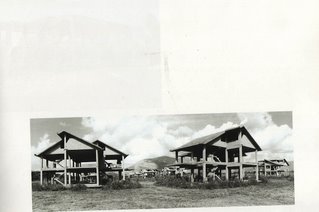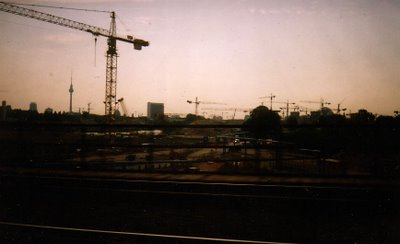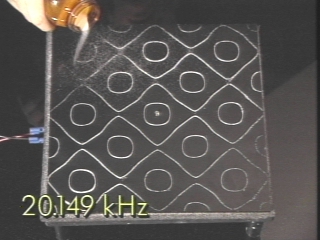We go around and around in the night and are consumed by fire.
This latin palindrome was attributed to the orator Sidonius Apollinaire, and reads identically forwards or backwards.
"The phrase that reverses itself, constructed letter by letter like a labyrinth, perfectly represents the form and content of perdition. We have not sought the formula by turning the world upside down in books, but by wandering around, together with four or five rather disreputable persons."
- Guy Debord,
(in Oeuvres Cinematographiques completes, Gallimard, Paris, 1994).
Wednesday, January 24, 2007
In the Archive
In the 1980s, the East German Stasi came to the realisation that their surveillance of citizens was so absurdly zealous that it had become impossible to manage, let alone utilise, the millions of files collected. By 1989, the Berlin headquarters of the Stasi contained nearly 7 million files collected by the East Germans on East German citizens crammed into 100 kilometres of storage space. Whilst some of the dossiers undoubtedly reviewed potentially incriminating material, the majority constituted a catalogue of banality. Even the most insignificant actions were reported and recorded. In 1987, an undercover agent denounced a housewife in his apartment block for allowing her daughter to wear blue jeans. Neighbours informed on their neighbours’ haircuts, telephone habits, or reported if their television aerials were oriented in a suspiciously western direction. Notes were filed on the fashion habits of known artists. There were eight kilometres of files of transcripts of phone conversations recorded in Berlin alone. Add to this the so-called "Bureau of Olfactory": a warehouse stacked with thousands of jars containing pieces of fabric stolen from houses (notably, dirty underwear and socks), that were used to train sniffer dogs to track suspects. It was joked at the time that the only information you needed to provide your taxi driver with was your name, for they would already know your address.
After the revolutions at the end of 1989, the files that hadn’t been destroyed by the Stasi were made available for public review. Which raised several questions; when everyone is on file, how can anyone possibly be incriminated? When every action is recorded, what constitutes history? And how are we to sift the clues from the junk? Within the archive, the inconsequential and the incriminating sit side by side.
After the revolutions at the end of 1989, the files that hadn’t been destroyed by the Stasi were made available for public review. Which raised several questions; when everyone is on file, how can anyone possibly be incriminated? When every action is recorded, what constitutes history? And how are we to sift the clues from the junk? Within the archive, the inconsequential and the incriminating sit side by side.
Stendhal Syndrome
Stendhal syndrome or Stendhal's syndrome is a psychosomatic illness that causes rapid heartbeat, dizziness, confusion and even hallucinations when an individual is exposed to art, usually when the art is particularly 'beautiful' or a large amount of art is in a single place. The term can also be used to describe a similar reaction to a surfeit of choice in other circumstances, e.g. when shopping.
It is named after the famous 19th century French author Stendhal (pseudonym of Henri-Marie Beyle), who described his experience with the phenomenon during his 1817 visit to Florence, Italy in his book Naples and Florence: A Journey from Milan to Reggio.
Although there are many descriptions of people becoming dizzy and fainting while taking in Florentine art, especially at the Uffizi, dating from the early 19th century on, the syndrome was only named in 1979, when it was described by Italian psychiatrist Graziella Magherini, who observed and described more than 100 similar cases among tourists and visitors in Florence. The syndrome was first diagnosed in 1982.
(Thanks Wikipedia)
It is named after the famous 19th century French author Stendhal (pseudonym of Henri-Marie Beyle), who described his experience with the phenomenon during his 1817 visit to Florence, Italy in his book Naples and Florence: A Journey from Milan to Reggio.
Although there are many descriptions of people becoming dizzy and fainting while taking in Florentine art, especially at the Uffizi, dating from the early 19th century on, the syndrome was only named in 1979, when it was described by Italian psychiatrist Graziella Magherini, who observed and described more than 100 similar cases among tourists and visitors in Florence. The syndrome was first diagnosed in 1982.
(Thanks Wikipedia)
Journey to the Moon

In 1865, the young French novelist Jules Verne published his third major work, Journey to the Centre of the Earth. The tale recounts the journey of Professor Lidenbrock and his nephew Axel through Iceland, toward an extinct crater, across a sunless sea and into the inner most recesses of the earth. Verne’s continuous provision of metereological and geographical detail in the novel is for the most part an accurate record of the Icelandic environs. Although Verne never travelled to Iceland personally, he familiarised himself with the territory via written descriptions and artistic impressions in scientific journals and periodicals of the time. It is also highly possible that Verne collaborated with librarians and geologists in the making of his text. The contract from Verne’s French publisher stipulates the services and employment conditions for geologists and librarians, who were to provide Verne with the data needed to “validate” his fictional landscape. The crater into which the travellers descend is still known today as the Snaeffelsjokull volcano, located south west of Reykjavik in the Snaeffelsjokull Peninsula National Park. For Verne’s contemporaries, this area provided an unearthly spectacle of sublime desolation. Its exoticism was matched only by accounts of Antarctica, at this time just entering public discussion in France. Marked with jagged, rocky outcrops and rivers of molten lava, Snaeffels Jokull is the perfect backdrop for an expedition into the unknown.
A century after the English translation of Verne’s book, the site again proved catalytic for the production of science-fiction. A year before Neil Armstrong and Buzz Aldrin took their historic steps on the moon they trained at a NASA base in north-east Iceland, not far from the site of Verne’s fiction. It was here that the first shots of a be-suited Neil Armstrong bounding across a rocky, lunar-like landscape were captured. Verne’s fictional account of the conquest of the earth’s interior was refashioned as a projection of extra-terrestrial activity. When the footage from Apollo 11 was broadcast back to Earth on July 20, 1969, its choreography had already been mapped out on that same desert of Icelandic lava. The aesthetic of history was determined by fictional parameters.
Incomplete Architecture

It is possible today to buy readymade houses from catalogue, newly built and newly furnished, with stainless steel appliances throughout and a lawnmower in the shed. This is the real estate equivalent of the gesamtkunstwerk; the “total package” of a domestic lifestyle. From the moment of purchase, clients set their clocks to the ticking of mortgage payments, monthly instalments and the rate of interest. Time is regulated by capital, segregate from the passage of historical or biological evolution.
Celebration was established by the Walt Disney Company in the mid 1990s, and is located only a short distance from Walt Disney World. As one resident of the community recently proclaimed; “Even though we must pay for the privilege, it's wonderful to live so close to Disney World. When you're not in the parks, you can still hear the distant echo of the fireworks each evening.” Celebration markets itself as a “real pre-1940s American town” but life in the exorbitantly priced estate is like inhabiting a billboard: a corporate microcosm, ringed like a moat by the security of Walt Disney’s family friendly signature. It even has its own soundtrack – muzak is piped continuously along the palm-tree lined main street – and property laws are in place to ensure that home-owners are prohibited from marring the Disney name (no “junk” littering the yard, no parking excessive amounts of cars on the street, no short term rentals). Everything is to be used, and nothing is to be created.
But there are models of inhabitation that have developed in opposition to the readymade, and those that can alter the culture of its use. In the Mediterranean, and particularly in Italy, the countryside is dotted with examples of “incomplete architecture”: skeletons of buildings, scaffolding still visible, which are nonetheless still inhabited as residences. The permanent state of construction is maintained in order to take advantage of a peculiar tax-loop hole in the regulatory framework. In these areas, property tax is due only after the building’s completion: if you don’t finish building, you don’t have to pay.
Chladni Plates
Excess or Overdose
Int., Night. A Paris Salon, sometime in the 1870s.
The room is crowded and hot, and we are pressed close up against the daguerrotypes mounted eclectically across one wall of the Salon. What a marvel it is, a scene composed from sunlight and science, preserved in a landscape of salt and silver...
Whereas both the visually minded "art critics" and the newly established bourgeoisie of the late 1800s may have found photography "excessively detailed" , "too faithful" and "lacking in focus"; a medium of "inhuman precision" and "artless mechanics", those involved in the acoustic realm apparently thought otherwise. Rather than lamenting the razing of visual hierachies, the figure over ground protocols that traditionally governed painterly composition, the thoughts of modernist inventors strayed elsewhere. Suddenly, the background became of immense interest, and the capturing of "fugitive" previously hidden phenomena appeared immanently possible: especially, it seems, in the world of sound.
Hoping to emulate some of the "qualities" of detailed, impervious photographic inscription, sonic scores were produced whereby every element was miked up, amplified, and recorded on site, before being mixed together to create what was intended to be a recording of "absolute acoustic fidelity". But whereas the photograph proferred a uniquely detailed composite of all elements in front of the lens, in acoustic terms there was no such equivalent, and no such legibility. To the phonographers' great disappointment, when they played their recordings back they found nothing but noise.
The room is crowded and hot, and we are pressed close up against the daguerrotypes mounted eclectically across one wall of the Salon. What a marvel it is, a scene composed from sunlight and science, preserved in a landscape of salt and silver...
Whereas both the visually minded "art critics" and the newly established bourgeoisie of the late 1800s may have found photography "excessively detailed" , "too faithful" and "lacking in focus"; a medium of "inhuman precision" and "artless mechanics", those involved in the acoustic realm apparently thought otherwise. Rather than lamenting the razing of visual hierachies, the figure over ground protocols that traditionally governed painterly composition, the thoughts of modernist inventors strayed elsewhere. Suddenly, the background became of immense interest, and the capturing of "fugitive" previously hidden phenomena appeared immanently possible: especially, it seems, in the world of sound.
Hoping to emulate some of the "qualities" of detailed, impervious photographic inscription, sonic scores were produced whereby every element was miked up, amplified, and recorded on site, before being mixed together to create what was intended to be a recording of "absolute acoustic fidelity". But whereas the photograph proferred a uniquely detailed composite of all elements in front of the lens, in acoustic terms there was no such equivalent, and no such legibility. To the phonographers' great disappointment, when they played their recordings back they found nothing but noise.
Visible Language

Many years before he invented the telephone, in the late 1800s in Scotland, Alexander Graham Bell (1847-1922) was enlisted as an assistant to his father, a speech teacher. Bell the elder was responsible for developing what he called "a system of visible language", composed of symbols depicting the actions of the vocal organs in action. He referred to the system as a "universal alphabet", and insisted that his letters, "instead of being arbitrary characters", were "symbolic representations of the organs of speech and of the way in which they were put together in uttering sound." Alexander would frequently participate in his father's "visible language" demonstrations, and the two travelled to Montreal, Canada to "teach" the language to small crowds of scientists and teachers. Young Bell's role was to "play" the sounds, to act as speaker for his father's records. When the child left the room, an audience member suggested a sound. Bell pere would then "write" it in his system of visible language (which resembled vibrating wave patterns), and Alexander, returning to the room, would decipher it. As he recalled, "it was just as easy to spell the sound of a cough, or a sneeze or a click to a horse, as a sound that formed an element of human speech." The nonlinguistic noises always attracted the greatest applause.
Alexander Graham Bell's mother and his wife Mabel were both deaf.
skinflakes
fish fish
oh fishy fishy
how salty fishy salt salt
how fishy salty fish fish
oh salty salty
oh crumby flaky scale
theres's scrambled custard and cold beans for breakfast if you want some
oh fishy fishy
how salty fishy salt salt
how fishy salty fish fish
oh salty salty
oh crumby flaky scale
theres's scrambled custard and cold beans for breakfast if you want some
Subscribe to:
Posts (Atom)



